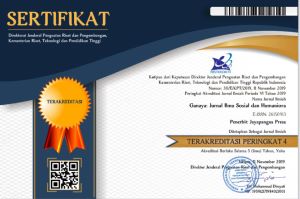Pemanfaatan Maksimum Sarana Dan Prasarana Sekolah Menengah Kejuruan (SMK) Karsa Mulya Dalam Rangka Meningkatkan Penerimaan Peserta Didik Baru
DOI:
https://doi.org/10.37329/ganaya.v7i2.2843Keywords:
Private Vocational High School, Facilities and Infrastructures, School Branding, School Capacity, Industrial and Business CommunityAbstract
SMK Karsa Mulya is a private SMK in Palangka Raya that has the highest enrolment-to-learner ratio among other SMKs in the region, according to Dapodik data. In addition, this SMK also accommodates the largest number of learners, reflecting the excellent utilisation of facilities and infrastructure in supporting its enrolment capacity. Despite the limited facilities and infrastructure, SMK Karsa Mulya is still able to attract a large number of junior high school graduates. The learning strategy and cooperation with Iduka (Industry and the World of Work) that is implemented can be an example of good practice for other schools, regardless of the level of completeness of facilities and infrastructure owned. The purpose of the research is to find out the school management from both the Principal and the teachers so that junior high school graduates are still interested in entering SMK Karsa Mulya. The research method used is qualitative. To obtain information and data, interviews were conducted with the principal, teachers, and students of SMA Karsa Mulya. The results showed that the maximum utilisation of existing facilities and infrastructure, cooperation, communication, and maintaining trust with Iduka to utilise the equipment they have, good school management, the seriousness of the teachers to teach and provide good character education, the application of rules to create discipline, good handling of student conflicts, and good communication with students and parents are factors that make SMK Karsa Mulya continue to get students continuously and increase from year to year. This shows that the limited facilities and infrastructure owned by a school are not a significant barrier in getting a large number of students.
References
Agung, I. (2014). Akademi Komunitas dan Penerapan Master Plan Perluasan dan Percepatan Pembangunan Ekonomi Indonesia (Mp3ei). JIV-Jurnal Ilmiah Visi, 9(1), 68–81.
Beland, L. P., & Kim, D. (2016). The Effect of High School Shootings on Schools and Student Performance. Educational Evaluation and Policy Analysis, 38(1), 113–126.
Bengre Taley, I. (2022). Do Students Like Us Because We Teach Well? The Popularity of High School Mathematics Teachers. Asian Journal for Mathematics Education, 1(4), 383–407.
Bettencourt, L., Simões, F., Fernandes, B., & Fonseca, J. (2023). Designing Vocational Training Policies in an Outermost European Region: Highlights from a Participatory Process. European Educational Research Journal, c.
Duflo, E. (2001). Schooling and Labor Market Consequences of School Construction in Indonesia: Evidence From an Unusual Policy Experiment. American Economic Review, 91(4), 795–813.
Fauzia, M. (2019). Meneliti SD Inpres di Era Soeharto, Ekonom AS Ini Raih Nobel Ekonomi Halaman all - Kompas.
Fieger, P., Villano, R. A., Rice, J., & Cooksey, R. (2017). Two Dimensional Efficiency Measurements in Vocational Education: Evidence from Australia. International Journal of Productivity and Performance Management, 66(2), 196–215.
Hyman, D. N. (2011). Public Finance, A Contemporary Application of Theory to Policy (J. Calhoun (ed.); 10th ed.). South Western Cengage Learning.
Lamberti, C. (2014). Selling “Choice”: Marketing Charter Schools in Chicago. 1–8.
Lenton, P. (2013). Routes to Educational Success for Low Achievers. Journal of Economic Studies, 40(2), 222–239.
Marni Mala, Y. P., Riyanto, Y., & Widodo, B. S. (2021). Peran Kepemimpinan Kepala Sekolah Dalam Mendukung Budaya dan Mutu SMPK Angelus Custos II Surabaya. Jurnal Ilmiah Mandala Education, 7(3).
Nasir, R., Hering, R. M., & Rosanti, A. (2021). Manajemen Sarana Prasarana di SD Inpres Umapura, Kecamatan Alor Barat Laut Kabupaten Alor. JIIP-Jurnal Ilmiah Ilmu Pendidikan, 4(8), 942–947.
Oktavia, R. A. (2018). Dinamika SD Inpres Di Kabupaten Bantul Tahun 1973-1983. Ilmu Sejarah-S1, 3(6).
Phillippo, K., Griffin, B., Dotto, B. J. D., Castro, D., & Nagi, E. (2021). School Choice, Youth Voice: How Diverse Student Policy Actors Experience High School Choice Policy. Educational Policy, 35(6), 949–984.
Pritaningrum, M., & Hendriani, W. (2013). Penyesuaian Diri Remaja yang Tinggal di Pondok Pesantren Modern Nurul Izzah Gresik pada Tahun Pertama. Jurnal Psikologi Kepribadian Dan Sosial, 2(3), 134–143.
Salameh, P., Kolokotroni, O., & Constantinou, C. (2022). Research, Ranking, and University Branding: Investment for Excellence in Health Professions’ Education. Pharmacy Education, 22(1), 404–408.
Simić, N., & Vukelić, M. (2023). The Transition to Vocational Secondary School in Serbia: A Two-Wave Moderated Mediation Study on School Climate, Teacher Support, Engagement and School Adjustment. SAGE Open, 13(1), 1–12.
Suryandari, S. (2019). Peraih Nobel Ekonomi Ternyata Meneliti SD Inpres di Indonesia.
Toraman, Ç., & Korkmaz, G. (2023). What is the “Meaning of School” to High School Students? A Scale Development and Implementation Study Based on IRT and CTT. SAGE Open, 13(3), 1–15.
Willyarto, M. N., Yunus, U., & Supeno. (2022). Digital Branding of Vocational High School with Industrial Partnership: Case Study of SMK Muhammadiyah Kandanghaur, Indonesia. ICETM 2022, 6.
Downloads
Published
How to Cite
Issue
Section
License
Copyright (c) 2024 Hamiduddin Arief Kaenong, Mohammad Benny Alexandri, Yogi Suprayogi Sugandi (Author)

This work is licensed under a Creative Commons Attribution-ShareAlike 4.0 International License.
An author who publishes in the Ganaya : Jurnal Ilmu Sosial dan Humaniora agrees to the following terms:
- Author retains the copyright and grants the journal the right of first publication of the work simultaneously licensed under the Creative Commons Attribution-ShareAlike 4.0 License that allows others to share the work with an acknowledgement of the work's authorship and initial publication in this journal
- Author is able to enter into separate, additional contractual arrangements for the non-exclusive distribution of the journal's published version of the work (e.g., post it to an institutional repository or publish it in a book) with the acknowledgement of its initial publication in this journal.
- Author is permitted and encouraged to post his/her work online (e.g., in institutional repositories or on their website) prior to and during the submission process, as it can lead to productive exchanges, as well as earlier and greater citation of the published work (See The Effect of Open Access).
Read more about the Creative Commons Attribution-ShareAlike 4.0 Licence here: https://creativecommons.org/licenses/by-sa/4.0/.








